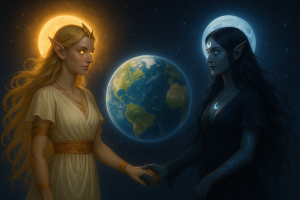-
History
The Second era – The Rise of Civilizations

Second Era – The Rise of Civilizations
Quintra and Denday had an honourable dual to see who was most powerful and Quintra won. The goddess moved her planet to the centre of this new star system and Eonil started orbiting around Quintra. Denday moved her planet to follow Eonil’s orbit around Quintra, forever remaining at the opposite side of Eonil to provide her soft light to the dark side of the planet.
And thus the second era started.
Even though Quintra had won the dual she agreed to have an equal rule with her twin sister. They both would rule the part of Eonil where their light would reach. But Eonil soon started to rotate around her own axis in the centre of the two planets and so day and night was born. This meant that on Eonil, Quintra ruled during the day and Denday ruled during the night.
For a long time, Quintra and Denday focused their powers on defeating the countless minions Ghor had left behind when they were banished. It likely took centuries before these chaotic beings were brought under control, hunted down, or destroyed. With Ghor’s presence removed, life on Eonil flourished.
Civilizations began to form, and for hundreds of years the influence of Ghor was believed to be gone, or at least diminished enough to be forgotten. Yet corruption was never truly defeated — it lay hidden, festering, waiting to spread again.
It was during this long peace that a group of Night Dwellers grew suspicious of what others ignored. They believed Ghor’s influence lingered, subtle and unseen, and so they journeyed west of the Xaverion island to the great continent where the mythic races — Eonil’s own creations — lived. There they converted to the worship of Eonil herself. Over time, their bodies slowly changed. They were no longer Night Dwellers, but something new: the Ee’dornil. Their transformation became a foreshadowing of the greater conflicts yet to come.
As centuries passed, magic was born from Eonil herself, a new force to battle corruption. She granted mystical abilities to her creatures, and the first dragons emerged as the keepers of magical knowledge. They taught others how to wield the arcane power flowing through the world. For a time, this seemed enough. But Ghor was able to twist even this gift, and when the first dragon was corrupted, it became clear that their influence could not be denied.
Legend says that Ghor eventually whispered into Quintra’s mind, clouding her judgment. She grew wary of Denday’s followers, who seemed to favour the gentle light of the night over the brightness of the day. Although Quintra had once agreed to rule equally with her sister, she began demanding that all should honour her above Denday. The night dwellers refused.
Tension mounted for decades, and after nearly a century of growing rivalry, Quintra finally attacked her sister in fury. She banished Denday from Eonil’s surface, striking the blue moon with such force that half of it fell dark. From that day forward, the blue moon spun slowly around its axis, its phases marking the passage of time. Denday herself was bound to her moon, never again able to walk upon Eonil.
Without Denday’s full blessing, her followers were hunted down by Quintra’s worshippers. Within only a few short years, the night dwellers were forced into hiding, retreating to places where the sun could not reach. Quintra’s forces declared victory, and thus the Age of Light began.
